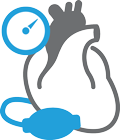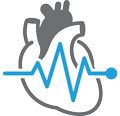Kaha Sciences telemetry solutions combine wireless power and state of the art pressure sensor technology to provide unrivaled accuracy and long-term recording in cardiovascular research.
With options to measure pressure (arterial, venous, and ventricular), ECG, sympathetic nerve activity, and tissue oxygen concentrations, 24/7 over the course of your experiment - Kaha Sciences' telemeters allow you to measure a range of cardiovascular signals to meet your research needs.
Related: Benefits of using telemetry in research »
Kaha Sciences Telemetry – Cardiovascular applications:
Pressure
Kaha Sciences rat pressure telemeters use the Millar Mikro-Tip® solid-state sensor technology, at the catheter tip to allow high fidelity, accurate, and repeatable pressure recordings. The 2 Fr (0.66 mm) sensor can record a range of pressures including; arterial blood pressure, venous pressure, and ventricular pressure.

Related: Benefits of using solid-state pressure sensors »
Telemeters are available with single (TRM54P) or dual (TRM54PP) catheters in lengths of 9, 15 or 25cm so customers can tailor their experiment and record up to two pressures with one telemeter.
The quality and accuracy of the signal allows confidence in basic feature extraction across animals (e.g. systolic, diastolic) but also facilitates more complex analysis such as spectral analysis and cardiac output from BP and dP/dt calculations from LVP.
Read more: Tips and Tricks for Successful Rat Telemetry Blood Pressure Recordings »
Publications:
- Sachdeva, R. et al. Noninvasive Neuroprosthesis Promotes Cardiovascular Recovery After Spinal Cord Injury. Neurotherapeutics (2021).
- Han, J.-C. et al. Left-Ventricular Energetics in Pulmonary Arterial Hypertension-Induced Right-Ventricular Hypertrophic Failure. Front. Physiol. 8, 1115 (2018).
- Griffiths, P. R. et al. Blockade of Rostral Ventrolateral Medulla Apelin Receptors Does Not Attenuate Arterial Pressure in SHR and L-NAME-Induced Hypertensive Rats. Front. Physiol. 9, 1488 (2018).
- Stehlin, E. et al. Chronic measurement of left ventricular pressure in freely moving rats. J. Appl. Physiol. 115, 1672–1682 (2013).
ECG
Biopotential telemeters (TR50B and TR50BB) allow the long-term recording of ECG, EMG, or EEG in freely moving rats. Our wireless power technology supports long-term, continuous recording at high sampling rates (2kHz) which is ideal for monitoring spontaneous pathophysiological activity, such as ectopic beats or the generation of arrhythmia.

The TRM54PB telemeter also allows customers to combine ECG and pressure measurements from the same animal to assess cardiac and cardiovascular function.
Publications:
- Kim, N. K., Wolfson, D., Fernandez, N., Shin, M. & Cho, H. C. A rat model of complete atrioventricular block recapitulates clinical indices of bradycardia and provides a platform to test disease-modifying therapies. Sci. Rep. 9, 6930 (2019).
- Zhang, D. et al. Reduced N‐Type Ca 2+ Channels in Atrioventricular Ganglion Neurons Are Involved in Ventricular Arrhythmogenesis. J. Am. Heart Assoc. 7, (2018).
Sympathetic Nerve Activity (SNA)
The TRM56SP telemeters allow users to simultaneously record concurrent blood pressure and SNA from the same animal. This is particularly useful in studies of the development of hypertension and cardiovascular control.
![]()
The input range of the SNA leads is ±60µV making it ideal for activity recording from fine, peripheral autonomic nerves.
Publications:
- McBryde, F. D., Liu, B. H., Roloff, E. V., Kasparov, S. & Paton, J. F. R. Hypothalamic paraventricular nucleus neuronal nitric oxide synthase activity is a major determinant of renal sympathetic discharge in conscious Wistar rats. Exp. Physiol. 103, 419–428 (2018).
- Salman, I. M., Sarma Kandukuri, D., Harrison, J. L., Hildreth, C. M. & Phillips, J. K. Direct conscious telemetry recordings demonstrate increased renal sympathetic nerve activity in rats with chronic kidney disease. Front. Physiol. 6, (2015).
Tissue Oxygen
The TR57Y tissue oxygen telemeter is the only device available on the market that can measure tissue oxygen concentration from conscious rats, in real-time.
![]()
The telemeter uses a stable carbon paste electrode and can measure local ischemia and tissue metabolic activity in the kidney and brain. Combined with our wireless power technology researchers have been able to assess circadian variability in kidney tissue oxygen thanks to the ability to record 24/7.
Related: Tissue oxygen telemetry - How does it work and why is it beneficial to your research? »
Publications:
- Thakkar, P.C. et al. Therapeutic Relevance of Elevated Blood Pressure After Ischemic Stroke in the Hypertensive Rats. Hypertension. 75, 740–747 (2020)
- Adamovich, Y. et al. Oxygen, and Carbon Dioxide Rhythms Are Circadian Clock Controlled and Differentially Directed by Behavioral Signals. Cell Metab. 29, 1092-1103.e3 (2019).
- Emans, T. W., Janssen, B. J., Joles, J. A. & Krediet, C. T. P. Circadian Rhythm in Kidney Tissue Oxygenation in the Rat. Front. Physiol. 8, (2017).
For more information about Kaha Sciences telemeters, or to discuss your specific research application please contact your nearest ADInstruments support representative.
Related resources:
Tips and tricks for long-term recordings of left ventricular pressure in rats »
Tips for handling and analyzing large telemetry data sets »
Five neuroscience applications using Kaha Sciences Telemetry »